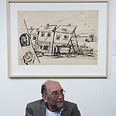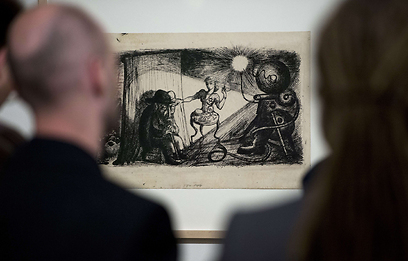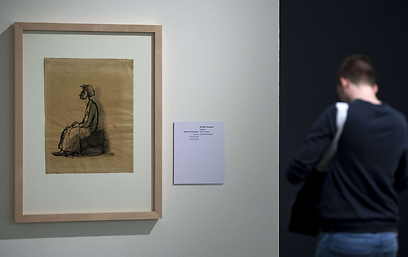
Hidden drawings from Nazi camp displayed
Jewish Museum in Berlin presents secret sketches that Czech artist produced, kept secret from his captors during World War II
Bedrich Fritta was 35 years old when he was imprisoned with his wife and baby son at the Theresienstadt Ghetto near Prague, which the Hitler propaganda machine vaunted as a "model camp" by hiding the true fate of Europe's Jews.
Artists, writers and musicians whose talents were exploited by the Nazis were held at the camp in the fortress town of Terezin in today's Czech Republic where Fritta, as head of a team of artists, had access to Indian ink and paper.
Clandestinely he built up a body of work including a drawing of a couple embracing by a food shop and perfumery, the facades of which fail to hide a mass grave of skulls and bones.
The picture was inspired by an International Red Cross visit in June 1944 when the Nazis ordered a massive clear up of the camp to give a good impression and deported some prisoners to Auschwitz to ease overcrowding.

'Film and Reality' (1944) by Bedrich Fritta (Photo: AFP)

Picture opening Fritta's book (Photo: AFP)
"In a terrible place, he produced terrible works," his grandson David Haas said at the exhibition's launch, alongside his elderly father, for whom Fritta drew his only colorful pictures from the camp.
His book "For Tommy on his third birthday" opens with a picture of a small rosy child looking out of a window and is in stark contrast to the otherwise dark skies, bare trees, tall walls and deformed faces drawn in black and white.
"It's a book showing a shocking contrast between the terrible situation that grandfather was living in and his role as a husband and father," Haas said.

'Before the Transport' (1943-44) (Photo: AFP)
Denis Gruenemeier, assistant curator, said he had been bowled over by the overall artistic quality.
"Although I didn't know these works, I was expecting something along the lines of realism but what I saw in fact at times reminded me of German expressionism...
or the symbolism of the 1900s," he said.
Fritta was among 87,000 deportees from the camp who eventually died in Auschwitz. His wife also perished. The hidden drawings were recovered by a surviving prisoner.
The exhibition runs until August 25.










